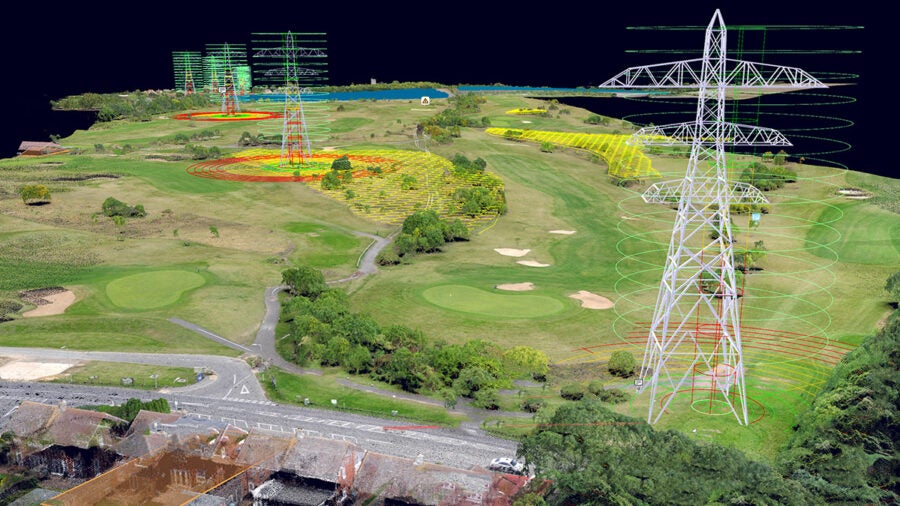
Over the next few decades, spending on new UK infrastructure will help the nation to meet future challenges. But designing huge civil engineering projects brings with it the potential for environmental damage and costly waste.
Whether it’s building new nuclear power stations and motorways or erecting electricity pylons and wind turbines, infrastructure planning must accommodate a wealth of regulations and safeguards designed to protect people and the planet.
It’s a mission which chimes with the B Corp philosophy of using “business as a force for good” and for James Dean, founder of Sensat, it’s something he takes seriously. He hopes his software platform will help deliver on that promise.
Sensat became a B Corp in 2022 and offers infrastructure teams globally the opportunity to visualise their projects and any related data within a real-world context. Plans can be plotted from anywhere on satellite-generated maps of the world to understand and prevent issues for the environment and society before they arise.
“Our mission is to help build and deliver infrastructure that’s crucial to the planet, without devastating impacts,” explains Dean, who says such billion-pound projects usually go over budget and over any projected timescale.
“Complex civil infrastructure projects matter to the world and a lot of the challenges we face as a species, such as population growth, climate resilience and the energy transition.”
A broken industry
Managing the capital delivery of infrastructure across different sectors is as complex as it is critical. For example, renewable energy generation must be connected to the National Grid and that impacts the landscape and residents.
Sensat’s ability to evaluate projects in a real-world scenario can drill down as deep as whether someone will suddenly find a new pylon appearing outside their bedroom window.
The system works with precise measurements and constraints such as elevations or protected habitats in the countryside. It can clearly and quickly show whether plan A will work, or whether plan B, C or even F might provide better value for money or be a more palatable option for the public.
Humanity needs to build infrastructure which offers a brighter future but we must make fewer negative impacts
“Companies must consider things that could go wrong,” says Dean. “If they find a handful of big problems but solve them before starting work, it will save them millions in costs and compensation and avoid environmental catastrophes.”
It’s those environmental challenges which dovetail with Sensat’s B Corp status. The software brings these to life in a way traditional CAD cannot. Rather than having to make a site visit in person, which is often difficult or costly, a planner can see all they need to know from their computer.
“It is just good business to do it this way,” says Dean. “We can show you ROI, we can show you faster; we can show you better. As a B Corp, we care about this.”
Speed and efficiency at scale
Whether it’s mapping terrain or understanding how construction traffic will negatively affect a town, Sensat can do in minutes what takes months to achieve in the real world. This helps to speed up planning permissions and licences.
“Humanity needs us to build this infrastructure – which is actually very exciting and offers a brighter future,” Dean adds. “But we must make fewer negative impacts and old processes are too slow when we need speed to hit net-zero targets.”
Dean points to the fact that it is easier to be compliant with increasing environmental monitoring legislation when digital tools are used to find a purpose in protecting nature.
As a B Corp, his company has used its technology on a pro-bono basis to map ecological loss and rare species at a rewilding site in Somerset. The B Corp framework also guides its decisions on which companies and which industries it is best placed to assist when preventing problems for the planet.
“It helps us to think about what we want to enable and what we don’t want to enable,” says Dean. “Of course, we won’t just only work with sustainable environmental projects. But we can at least lean into other projects and make sure they are built without destruction or mistakes. That’s the kind of future we want to be a part of.”
See Sensat in action at www.sensat.co

Over the next few decades, spending on new UK infrastructure will help the nation to meet future challenges. But designing huge civil engineering projects brings with it the potential for environmental damage and costly waste.
Whether it’s building new nuclear power stations and motorways or erecting electricity pylons and wind turbines, infrastructure planning must accommodate a wealth of regulations and safeguards designed to protect people and the planet.
It’s a mission which chimes with the B Corp philosophy of using “business as a force for good” and for James Dean, founder of Sensat, it’s something he takes seriously. He hopes his software platform will help deliver on that promise.

